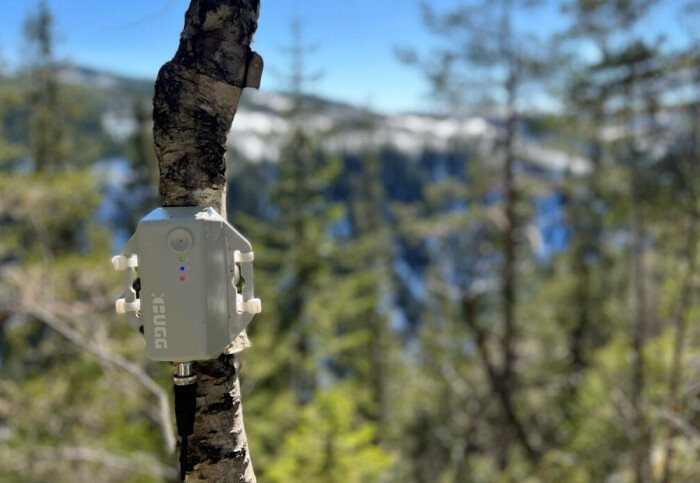Sounds of European nature to be mapped by automatic audio monitoring

A cost-effective real-time acoustic monitoring system developed by an Imperial academic will be used across Europe to map bird biodiversity.
The real-time acoustic monitoring devices designed by Imperial academic, Dr Sarab Sethi, will be used to track avian biodiversity across Europe. The Bugg system, previously used to map Norwegian, Malaysian, Mexican, and Taiwanese ecosystems, will now be distributed in the Netherlands, France, and Spain as a part of the TABMON project.
Funded by the Biodiversa+, the project will develop a transnational biodiversity monitoring system operating across a large range of latitudes – from the Mediterranean to the Arctic. Using 120 Bugg devices, the project aims to uncover the potential of acoustic sensing, demonstrating how it can complement the existing biodiversity monitoring systems as well as provide new reporting data for important programmes, such as the EU Biodiversity Strategy for 2030.
“Audio sensing systems such as Bugg allow us to monitor biodiversity on vast scales in a cost-effective way, complementing and directing more detailed traditional field surveys.” Dr Sarab Sethi
Bugg is an audio sensing system developed by Dr Sethi and his research team. It comprises an acoustic monitoring device, which continuously records sound and uploads it to a cloud service in real-time via mobile SIM cards. These sound recordings are then processed by the second part of the Bugg system – the artificial intelligence – which uses advanced machine learning algorithms to analyse the soundscape of the place. This makes monitoring of biodiversity easier, cheaper, and more ecological, producing a comprehensive picture of the regional biosphere.
Dr Sethi and his collaborators have been working on the Bugg system since 2018, with prototypes tested at the SAFE project in Borneo. The system was refined then deployed again in 2022 during The Sound of Norway project, which used the Bugg technology to analyse the distribution and migration patterns of birds in Norwegian forests. The device designed by Dr Sethi proved to be robust and reliable in collecting and transmitting high-quality audio data even in harsh environments.
Dr Sethi said: “Audio sensing systems such as Bugg allow us to monitor biodiversity on vast scales in a cost-effective way, complementing and directing more detailed traditional field surveys.”

Unlike the first version of the Bugg, the new version of the system allows researchers to use higher-quality external microphones, and record sound at higher sampling rates, which can capture the sounds of, for instance, ultrasonic bats and insects. More than 100 upgraded devices were sent to research centres across Europe this month and will be used over the next three years to collect and analyse biodiversity data. It is the first time that the devices will be used by external collaborators and on such a large scale.
Using sound to better understand the environment
In collaboration with the American manufacturer GroupGets, a total of 180 Bugg devices have been produced so far, but the interest in the technology is constantly growing. Several devices were recently ordered by the University of Stirling for the Forth Environmental Resilience Array (Forth-ERA), a digital observatory of the Firth of Forth catchment located in Scotland. Bugg will be used alongside other systems to gather and analyse environmental data about the Firth of Forth and its biosphere.
Due to increased interest in the Bugg system, Dr Sethi and his team are exploring ways to make it available to the wider public and other scientists. He said: “We are seeing growing interest in our technology and considering how we can make it accessible to others around the world beyond our immediate collaboration networks.”

With more audio systems deployed around the world in the future, acoustic sensing has the real potential to deliver global impact and help address environmental challenges. In a recent study published in PNAS, Dr Sethi along with researchers from the Norwegian Institute for Nature Research, National Taiwan University, University College London, London, and Academia Sinica, demonstrated how audio data of animal vocalisations may be used as an inexpensive way to survey ecosystems.
The study, conducted across Norway, Taiwan, Costa Rica, and Brazil, shows that autonomous and scalable acoustic monitoring can be used to effectively track changes to the biosphere on a small scale (e.g., a distribution of a specific species across disturbed landscapes) as well as a large scale (e.g., multi-year bird community migration dynamics). However, while even a single vocalisation classification model can deliver reliable results, the study emphasises that expert input is still required to verify data and calibrate algorithms in order to unlock broader biodiversity insights.
In the long-term, improved performance of machine learning models could provide invaluable insights into ecosystems, substantially enhancing our understanding of the environment and our impact on it. Dr Sethi said: “Improving machine learning algorithms will enable us to achieve more precise and reliable results when processing substantial quantities of data. With autonomous sensing technology and the large datasets available through projects such as TABMON, we hope to improve our understanding of biodiversity patterns and dynamics and answer urgent questions about the impact of climate change on our ecosystems.”
Article text (excluding photos or graphics) © Imperial College London.
Photos and graphics subject to third party copyright used with permission or © Imperial College London.
Reporter
Wiktoria Tunska
Institute of Global Health Innovation